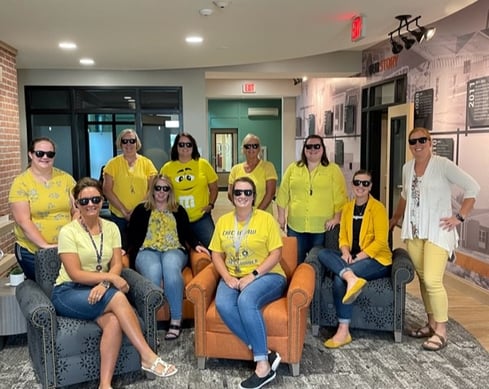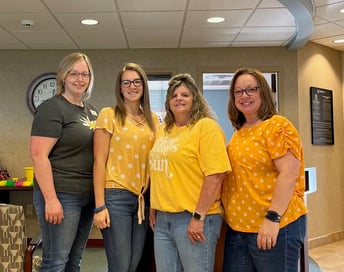Ultraviolet Safety Awareness: Protecting Your Skin from Harmful Rays
 While basking in the sun can be a great way to relax and enjoy the outdoors, it's important to remember that UV rays can cause serious harm to your skin and overall health. These harmful rays can penetrate the skin, causing damage to the DNA in your cells and increasing your risk of developing skin cancer. Additionally, UV exposure can also lead to premature aging, sunburn, and eye damage. It's important to prioritize UV safety by taking measures such as wearing protective clothing, using sunscreen, and avoiding prolonged exposure to the sun. By doing so, you can protect your skin and maintain your overall health and well-being.
While basking in the sun can be a great way to relax and enjoy the outdoors, it's important to remember that UV rays can cause serious harm to your skin and overall health. These harmful rays can penetrate the skin, causing damage to the DNA in your cells and increasing your risk of developing skin cancer. Additionally, UV exposure can also lead to premature aging, sunburn, and eye damage. It's important to prioritize UV safety by taking measures such as wearing protective clothing, using sunscreen, and avoiding prolonged exposure to the sun. By doing so, you can protect your skin and maintain your overall health and well-being.
 Understanding UV Rays
Understanding UV Rays
UV rays are a form of radiation emitted by the sun that can be harmful to our skin. There are two types of UV rays that reach the earth's surface: UVA and UVB. UVA rays are longer and can penetrate deeper into the skin, causing premature aging, wrinkles, and age spots. UVB rays, on the other hand, are shorter and primarily affect the outer layer of the skin, causing sunburn and increasing the risk of skin cancer.
Prolonged exposure to UV rays can have serious consequences for our health. In addition to skin cancer and premature aging, UV radiation can also damage our eyes, leading to cataracts and other eye problems. It's important to take precautions to protect ourselves from UV rays, such as wearing protective clothing, using sunscreen, and avoiding direct sunlight during peak hours. By staying informed about the dangers of UV radiation and taking proactive measures to stay safe, we can enjoy the sun without putting our health at risk.
 The Importance of UV Protection
The Importance of UV Protection
Protecting your skin from UV rays provides numerous benefits beyond avoiding skin cancer. UV rays can cause premature aging, sunburn, and other skin damage, but by taking measures to protect yourself, you can maintain youthful, healthy skin. When it comes to choosing the right sunscreen, look for a broad-spectrum sunscreen with an SPF of at least 30 that is water-resistant. Additionally, wearing protective clothing such as hats, sunglasses, and long sleeves can provide extra protection. Remember to limit your time in direct sunlight, especially during peak hours, and seek shade when possible. By prioritizing UV safety, you can enjoy the outdoors while maintaining your overall health and well-being.
Common Myths About UV Safety
Don't fall for these common misconceptions about UV safety - learn the truth about protecting your skin.
Myth: You Don't Need Sunscreen on Cloudy Days
Many people believe that they don't need to use sunscreen on cloudy days, but this is a common misconception. While clouds may block some of the sun's visible light, they don't necessarily block UV rays. In fact, up to 80% of UV radiation can penetrate through clouds, meaning that you can still get sunburned on a cloudy day. Additionally, some surfaces like sand, water, and snow can reflect UV rays, increasing your exposure even on cloudy days. Therefore, it's important to wear sunscreen with at least SPF 30, even on overcast days, to protect your skin from harmful UV rays.
Myth: Tanning Beds Are Safe
Tanning beds have become popular in recent years as an alternative to traditional sunbathing. However, they pose a significant danger to your skin and overall health. Tanning beds emit both UVA and UVB rays, which can penetrate deep into the skin and cause DNA damage. This damage can increase your risk of developing skin cancer, including melanoma, the deadliest form of skin cancer. In fact, people who use tanning beds before the age of 35 increase their risk of developing melanoma by 75%. Additionally, tanning beds can also cause premature aging, sunburn, and eye damage.
Instead of using tanning beds, there are safer ways to achieve a healthy glow. One option is to use self-tanning products, which do not rely on UV rays to darken the skin. These products contain dihydroxyacetone (DHA), a colorless sugar that reacts with amino acids in the skin's surface to produce a brown color. Another option is to use spray tans or airbrushing, which can provide a natural-looking tan without the harmful effects of UV radiation. By choosing safer alternatives to tanning beds, you can protect your skin and maintain your overall health and well-being.
UV Damage Warning Signs
Being aware of the warning signs of UV damage can help us take prompt action and protect ourselves. Pay attention to these indicators:
-
Sunburn: Red, swollen, and painful skin after sun exposure.
-
Uneven Pigmentation: Dark patches, freckles, or spots that develop on the skin.
-
Premature Aging: Wrinkles, fine lines, and sagging skin.
-
Eye Irritation: Redness, sensitivity to light, and discomfort.
-
Actinic Keratosis: Rough, scaly patches that may become cancerous if left untreated.
-
Changes in Moles: Irregular shape, size, or color of existing moles.
If you notice indicators of UV damage such as sunburn, uneven pigmentation, premature aging, eye irritation, or changes in moles, it's essential to take prompt action. First and foremost, seek shade and limit your exposure to the sun, especially during peak hours. If you have concerns about existing moles or other skin irregularities, make an appointment with a dermatologist.
How to Stay Safe in the Sun
Now that we understand the risks, let's explore some practical tips to protect ourselves from harmful UV rays:
-
Apply Sunscreen: Use a broad-spectrum sunscreen with an SPF of 30 or higher, and remember to reapply every two hours or after swimming or sweating.
-
Seek Shade: Limit direct exposure to the sun, especially during peak hours between 10 a.m. and 4 p.m.
-
Wear Protective Clothing: Cover your skin with lightweight, tightly woven clothing, broad-brimmed hats, and UV-blocking sunglasses.
-
Avoid Tanning Beds: Indoor tanning devices emit harmful UV radiation and increase the risk of skin cancer.
-
Stay Hydrated: Drink plenty of water to keep your skin hydrated and healthy.
Remember, when it comes to UV safety, prevention is key!
The Importance of Education
Education is critical when it comes to promoting UV safety. By raising awareness about the dangers of UV radiation and sharing tips on how to protect oneself, we can help prevent skin cancer and other related health problems. One of the best ways to spread awareness is through public health campaigns and educational initiatives. These can include social media campaigns, community outreach programs, and school-based education programs that teach people about the importance of UV safety.
Another way to spread awareness is through partnerships with healthcare professionals. Dermatologists and other healthcare providers can play a critical role in educating patients about the dangers of UV radiation and providing tips on how to protect oneself. They can also help detect skin cancer early, which can improve treatment outcomes and increase the chances of a full recovery.
The impact of education on public health cannot be overstated. By educating people about the dangers of UV radiation, we can help prevent skin cancer and other related health problems. This, in turn, can reduce healthcare costs and improve overall quality of life. By working together to promote UV safety, we can protect our skin and maintain our overall health and well-being.
At Osgood Bank, we believe in the power of community and spreading awareness. This July, we invite you to join us in promoting UV safety. Share these vital tips with your friends, family, and colleagues. Encourage them to adopt healthy sun habits, wear sunscreen daily, and undergo regular skin check-ups. Together, we can make a difference and create a culture of skin protection and well-being.
Sources:
American Academy of Dermatology
Forbes: 5 Common Sunscreen Myths You Need To Stop Believing